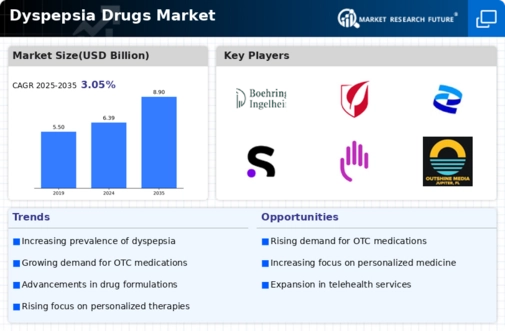Rising Geriatric Population
The increasing geriatric population is a significant factor driving the Dyspepsia Drugs Market. Older adults are more susceptible to gastrointestinal disorders, including dyspepsia, due to age-related physiological changes and comorbidities. According to demographic data, the population aged 65 and older is projected to reach 1.5 billion by 2050, which will likely lead to a corresponding rise in dyspepsia cases. This demographic shift necessitates the development of tailored treatment options that cater to the unique needs of older patients. Consequently, pharmaceutical companies are focusing on creating formulations that are both effective and safe for this vulnerable population, thereby enhancing market prospects.
Growing Prevalence of Dyspepsia
The rising incidence of dyspepsia is a primary driver for the Dyspepsia Drugs Market. Studies indicate that approximately 25% of the population experiences dyspeptic symptoms at some point in their lives. This increasing prevalence is attributed to lifestyle changes, dietary habits, and stress levels. As more individuals seek relief from discomfort associated with dyspepsia, the demand for effective pharmacological solutions intensifies. Consequently, pharmaceutical companies are focusing on developing innovative drugs tailored to alleviate symptoms. This trend is likely to bolster the market, as healthcare providers increasingly prescribe medications to manage dyspepsia, thereby enhancing patient quality of life.
Advancements in Drug Formulations
Innovations in drug formulations are significantly influencing the Dyspepsia Drugs Market. Recent advancements have led to the development of more effective and targeted therapies, which are designed to provide quicker relief from dyspeptic symptoms. For instance, the introduction of novel proton pump inhibitors and H2-receptor antagonists has transformed treatment protocols. Market data suggests that the segment of proton pump inhibitors is expected to witness substantial growth, with a projected CAGR of around 5% over the next few years. These advancements not only improve patient outcomes but also encourage healthcare professionals to adopt newer therapies, thereby driving market expansion.
Regulatory Support for Drug Approvals
Regulatory support for the approval of new dyspepsia drugs is fostering growth in the Dyspepsia Drugs Market. Regulatory agencies are increasingly streamlining the approval process for innovative therapies, which encourages pharmaceutical companies to invest in research and development. This supportive environment is crucial for bringing new and effective treatments to market, addressing the unmet needs of patients suffering from dyspepsia. As a result, the number of new drug applications has risen, with several promising candidates currently undergoing clinical trials. This trend not only enhances competition within the market but also provides patients with a broader range of treatment options.
Increasing Awareness of Gastrointestinal Health
The growing awareness surrounding gastrointestinal health is propelling the Dyspepsia Drugs Market. Educational campaigns and health initiatives have heightened public understanding of dyspepsia and its implications. As individuals become more informed about the importance of gastrointestinal well-being, they are more likely to seek medical advice and treatment for dyspeptic symptoms. This shift in consumer behavior is reflected in the rising sales of dyspepsia medications, as patients actively pursue solutions to manage their conditions. Furthermore, healthcare providers are increasingly emphasizing the need for effective treatment options, which further stimulates market growth.


















Leave a Comment